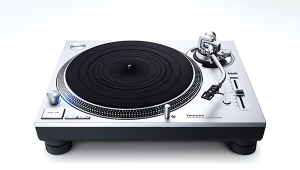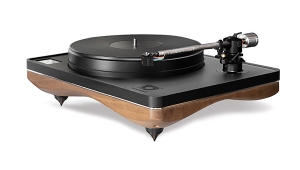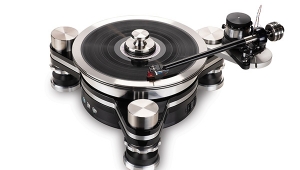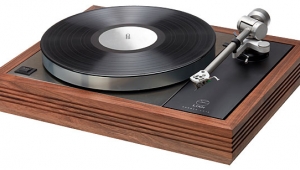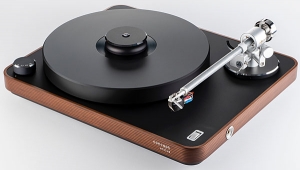| Columns Retired Columns & Blogs |
Linn Sondek LP12 turntable with Lingo power supply Measurements
Sidebar 2: Measurements
Footnote 1: The easiest way to remember which side is which is: "Left is Logical; Right is Romantic."—John Atkinson
I hadn't intended to do any measurements. But I couldn't resist it. That ol' left-brain insisted on having its way (footnote 1). So I put on Denon's XL7007A test LP, cued up the 3kHz track, plugged in the frequency meter—3000Hz, right on the button at 33.3rpm; 4049.5Hz at 45rpm. (These were the mean values; as with every other turntable I've measured with a digital meter, the indicated value bobbled a little.)
To look at the speed stability in more detail, I captured a 1kHz tone (actually 1003Hz on the Denon LP) with DRA Labs' MLSSA system (footnote 2) set in distortion-analysis mode with a 2kHz bandwidth. Transforming to the frequency domain courtesy of Monsieur Fourier allowed me to look at the spectrum of that tone. Fig.1, which displays the Troika's output from 800 to 1200Hz with a 2Hz resolution, shows a relatively pure 1003Hz component (actually 1004Hz) with the first sidebands at ±11Hz, these caused by the Ekos/Troika's fundamental resonance. Two more sets of sidebands appear, with then a major set at ±50Hz. This is the Lingo's driving frequency, but as the sidebands are 65dB down from the 0dB = 5cm/s reference level, I imagine they are subjectively inconsequential.

Fig.1 Spectral analysis, 800-1200Hz, of 1003Hz tone at 5cm/s, after RIAA equalization, reproduced by Linn LP12/Lingo/Ekos/Troika (linear frequency scale, frequency resolution = 2Hz).
For comparison, fig.2 shows the identical measurement taken on my wife's LP12 Valhalla/Ittok/DL103D, and fig.3 that on one of the LP players set up in Stereophile's listening room, the Australian Aura, fitted with the excellent Graham tonearm carrying a Rowland Complement cartridge. The Valhalla spectrum is very similar to that of the Lingo Sondek, apart from an increase in the measured frequency of the test tone to 1006Hz, the absence of 50Hz sidebands, and the tonearm sidebands being placed at ±14Hz. The fundamental peak also can be seen to have slightly wider "skirts."

Fig.2 Spectral analysis, 800-1200Hz, of 1003Hz tone at 5cm/s, after RIAA equalization, reproduced by Linn LP12/Valhalla/Ittok/Denon DL103D (linear frequency scale, frequency resolution = 2Hz).
In the Aura spectrum, the FFT missed the lower tonearm-resonance sideband, but the upper one, at +8Hz, can be made out. The speed is also slightly high, with the 1003Hz tone replaying as 1009Hz. Note the very strong sidebands at ±26Hz, 50dB down from the fundamental and the fact that the noise floor is generally higher in level than with the Linn player.
What can I draw from these measurements? Certainly nothing that would indicate why the Linn/Lingo appears to dig down an extra octave in the bass. But two things do strike me. One, the tonearm low-frequency resonance appears to dominate measurements of a turntable's speed stability, though the Lingo-powered LP12 is excellent, nevertheless, in that it produces a clean fundamental peak in the spectrum. And two, the LP12/Ekos/Troika is mechanically well-matched, as you might expect from an LP player with all the parts sourced from the same manufacturer. The tonearm resonance is both well-damped and well-placed at 11Hz or so.

Fig.3 Spectral analysis, 800-1200Hz, of 1003Hz tone at 5cm/s, after RIAA equalization, reproduced by Aura/Graham/Rowland Complement (linear frequency scale, frequency resolution = 2Hz).
Further thoughts in 2002: With hindsight, I should have published fig.4 in the original review, which is a wider-bandwidth spectrum of the RIAA-equalized 1003Hz tone as reproduced by the LP12/Lingo/Ekos/Troika combination. First, note how the RIAA-equalized noisefloor gently slopes down from the low bass through to the low treble. As has been pointed out by Meridian's Bob Stuart, the noise of LP playback systems tracks the sensitivity curve of human hearing, so that the perceived dynamic range is greater than the unweighted S/N ratio might suggest.
Second, the 0dB reference level for this graph is a 5cm/s recorded velocity. As peak recorded velocities can be at least 15dB higher than this, the analog noise-floor components in the region where the ear is most sensitive are around 90dB down from that level, which is impressive for a system that relies on a rock dragged along a plastic groove.
Third, a component at the preamp's typical power supply frequency of 120Hz can be seen just above the -60dB line (0.1%). The large amount of preamp gain required by the RIAA curve at low frequencies mandates heroic grounding and power supply design for the phono preamp designer. (All this graphs for this review were taken with Ben Duncan's otherwise deathly quiet AMP-01 design, described in 1984 issues of the English magazine Hi-Fi News & Record Review.)
Finally, fig.4 shows that the sidebands at ±50Hz that I mentioned back in 1991 are actually part of a series. Although all are at -65dB or below, I was a little perturbed to see them. I suspect that they are inherent in the behavior of a synchronous motor, which will "cog" due to the finite number of magnetic poles (24, I believe, in the Sondek's motor). The moment of inertia of the rotating platter and the compliance of the belt that drives it form a low-pass filter that ideally should eliminate the effects of such "cogging." Evidently, while the LP12's filter does reduce the level of the 50Hz components, it doesn't remove them entirely.

Fig.4 Spectral analysis, 10Hz-2kHz, of 1003Hz tone at 5cm/s, after RIAA equalization, reproduced by Linn LP12/Lingo/Ekos/Troika (logarithmic frequency scale, frequency resolution = 2Hz).
If you are thinking that a servo-controlled direct-drive design would be the way to eliminate these spuriae, think on this: in a direct-drive turntable, the motor acts directly on the platter spindle. There is therefore no mechanical filter to reduce the effect of any variations from perfect rotational behavior on the part of the motor. In addition, all servo systems will have a natural frequency around which they will "hunt," albeit in a damped manner in a well-designed system. In the direct-drive turntables that were popular in the 1970s, this natural servo frequency was around 3kHz—right in the middle of the region where the ear is most sensitive. Is it any wonder, therefore, that the original synchronous-motored Sondek trounced the direct-drive competition in those A/B comparisons a quarter century ago?—John Atkinson
Footnote 1: The easiest way to remember which side is which is: "Left is Logical; Right is Romantic."—John Atkinson
Footnote 2: I keep finding new uses for DRA Laboratories MLSSA system, which is possibly the best bargain in test equipment around right now, incorporating as it does a complete 12-bit storage oscilloscope with a programmable anti-aliasing filter, a digital signal generator, and a wide variety of post-processing software for around $3000.—John Atkinson
- Log in or register to post comments
